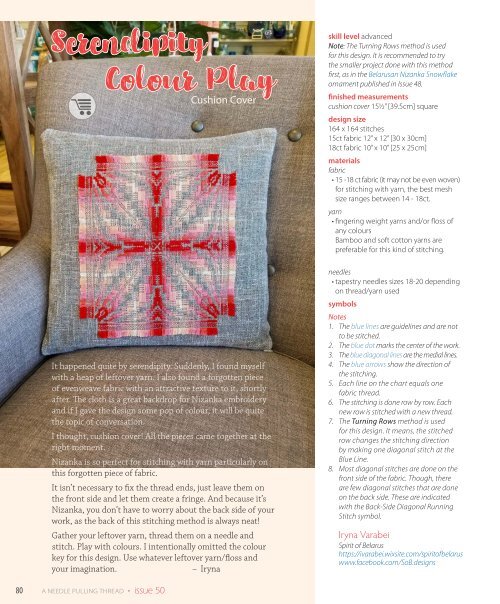A Needle Pulling Thread Issue 50 Sampler
This issue is dedicated to those who hold on to cherished textiles in the hope that one day they will be enlightened on how to repurpose them in a new fashion. Call it an upcycling issue if you will, you'll find original ways of transforming knitted and sewn clothing, threads, and cherished items into something new. Also in this issue, are topics like the Monk's cloth crisis, and which cloth is used instead for Swedish weaving, and, Diamond Petals by Judith Marquis, another tutorial on fabric manipulation that looks very much like dragon scales. It's a pleasure to announce we have a new quilting column, The Quilter's Connection, written by Heather McArthur. See what she has to say about what to do with old and worn quilts. And you don't want to miss the solution to the conundrum about stashing yarn, 'To Stash or Not to Stash' written by Knitting Contributor, Cynthia MacDougall. This is a topic we all struggle with, see how Cynthia's experience helps to put what we think of our yarn stash into perspective and clear the yarn clutter without feeling like we're giving up something precious. Enjoy the issue.
This issue is dedicated to those who hold on to cherished textiles in the hope that one day they will be enlightened on how to repurpose them in a new fashion. Call it an upcycling issue if you will, you'll find original ways of transforming knitted and sewn clothing, threads, and cherished items into something new. Also in this issue, are topics like the Monk's cloth crisis, and which cloth is used instead for Swedish weaving, and, Diamond Petals by Judith Marquis, another tutorial on fabric manipulation that looks very much like dragon scales. It's a pleasure to announce we have a new quilting column, The Quilter's Connection, written by Heather McArthur. See what she has to say about what to do with old and worn quilts. And you don't want to miss the solution to the conundrum about stashing yarn, 'To Stash or Not to Stash' written by Knitting Contributor, Cynthia MacDougall. This is a topic we all struggle with, see how Cynthia's experience helps to put what we think of our yarn stash into perspective and clear the yarn clutter without feeling like we're giving up something precious. Enjoy the issue.
Create successful ePaper yourself
Turn your PDF publications into a flip-book with our unique Google optimized e-Paper software.
Serendipity<br />
Colour Play<br />
Cushion Cover<br />
skill level advanced<br />
Note: The Turning Rows method is used<br />
for this design. It is recommended to try<br />
the smaller project done with this method<br />
first, as in the Belarusan Nizanka Snowflake<br />
ornament published in <strong>Issue</strong> 48.<br />
finished measurements<br />
cushion cover 15½” [39.5cm] square<br />
design size<br />
164 x 164 stitches<br />
15ct fabric 12” x 12” [30 x 30cm]<br />
18ct fabric 10” x 10” [25 x 25cm]<br />
materials<br />
fabric<br />
• 15 -18 ct fabric (it may not be even woven)<br />
for stitching with yarn, the best mesh<br />
size ranges between 14 - 18ct.<br />
yarn<br />
• fingering weight yarns and/or floss of<br />
any colours<br />
Bamboo and soft cotton yarns are<br />
preferable for this kind of stitching.<br />
It happened quite by serendipity. Suddenly, I found myself<br />
with a heap of leftover yarn. I also found a forgotten piece<br />
of evenweave fabric with an attractive texture to it, shortly<br />
after. The cloth is a great backdrop for Nizanka embroidery<br />
and if I gave the design some pop of colour, it will be quite<br />
the topic of conversation.<br />
I thought, cushion cover! All the pieces came together at the<br />
right moment.<br />
Nizanka is so perfect for stitching with yarn particularly on<br />
this forgotten piece of fabric.<br />
It isn’t necessary to fix the thread ends, just leave them on<br />
the front side and let them create a fringe. And because it’s<br />
Nizanka, you don’t have to worry about the back side of your<br />
work, as the back of this stitching method is always neat!<br />
Gather your leftover yarn, thread them on a needle and<br />
stitch. Play with colours. I intentionally omitted the colour<br />
key for this design. Use whatever leftover yarn/floss and<br />
your imagination.<br />
– Iryna<br />
needles<br />
• tapestry needles sizes 18-20 depending<br />
on thread/yarn used<br />
symbols<br />
Notes<br />
1. The blue lines are guidelines and are not<br />
to be stitched.<br />
2. The blue dot marks the center of the work.<br />
3. The blue diagonal lines are the medial lines.<br />
4. The blue arrows show the direction of<br />
the stitching.<br />
5. Each line on the chart equals one<br />
fabric thread.<br />
6. The stitching is done row by row. Each<br />
new row is stitched with a new thread.<br />
7. The Turning Rows method is used<br />
for this design. It means, the stitched<br />
row changes the stitching direction<br />
by making one diagonal stitch at the<br />
Blue Line.<br />
8. Most diagonal stitches are done on the<br />
front side of the fabric. Though, there<br />
are few diagonal stitches that are done<br />
on the back side. These are indicated<br />
with the Back-Side Diagonal Running<br />
Stitch symbol.<br />
Iryna Varabei<br />
Spirit of Belarus<br />
https://ivarabei.wixsite.com/spiritofbelarus<br />
www.facebook.com/SoB.designs<br />
●<br />
80 A NEEDLE PULLING THREAD issue <strong>50</strong>

















